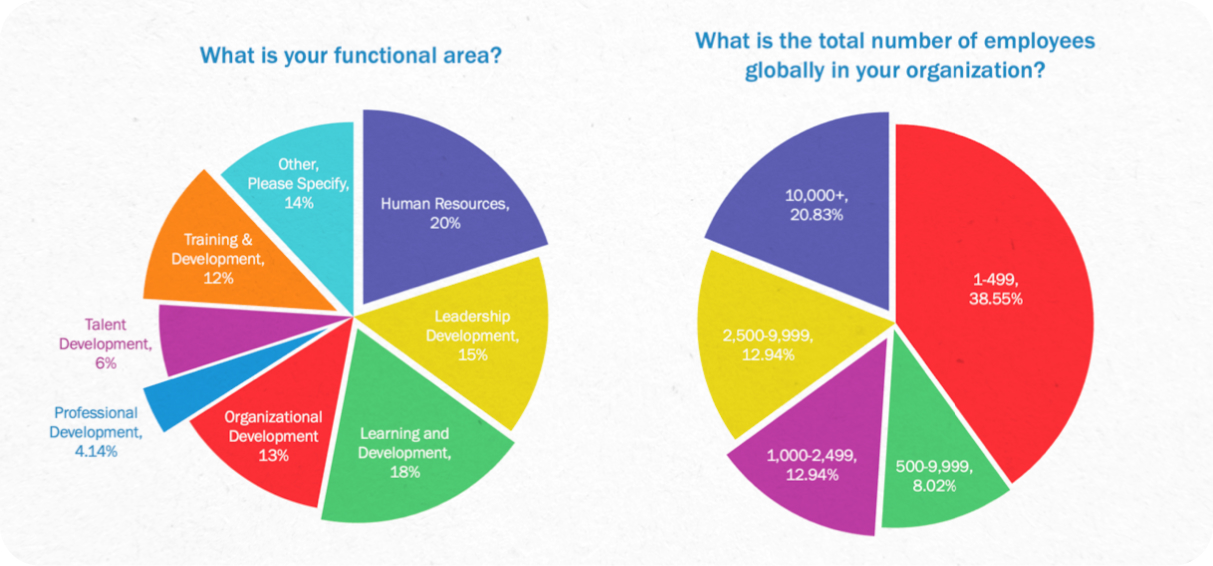2023 HR and L&D Trends
Enhancing the employee experience in a hybrid world
2023 HR and L&D Trends
Enhancing the employee experience in a hybrid world
We surveyed over 700 leadership, learning, and talent development professionals
For our 4th annual HR/L&D Trends report, Blanchard surveyed over 700 leadership, learning, and talent development professionals to discover how they are dealing with changes in the work environment and what they are doing from an HR and L&D perspective.
Respondents were asked about their top challenges as they navigate a new hybrid world. A special emphasis was placed on hiring and retention. A close look was taken at employee experience and engagement.
One unique feature of the Blanchard survey was the use of structured and unstructured response formats. Participants were asked qualitative open- ended questions together with quantitative multiple-choice options. This allowed the Blanchard report to contain both data types to paint a more complete picture of what respondents were experiencing.
Participants in this year’s survey certainly saw a connection between leadership capability and employee experience. They expressed concerns about the impending retirements of current leaders and the sheer number of new managers that need to be trained.
In the end, this year’s survey paints a picture of organizations in flux—but also rebounding. The war for talent, the challenge of employee retention, and raised expectations of today’s workforce have all combined to put a renewed interest in the role leaders play.
HR TOP challenges & objectives
In the first open-text section of the survey, respondents were asked: What is the biggest challenge you are facing as an HR/L&D leader going into 2023? Respondents cited challenges ranging from the economy, recruiting, retention, dealing with change, and the hybrid work environment.

From an HR perspective, the top open-text responses in descending order were:
- Having enough capacity and resources to meet the needs of workforce development
- Reducing turnover and attrition
- Improving engagement and experience
- Developing culture despite shifts to hybrid work arrangements
Capacity & resources
Resourcing issues tended to break down into three areas when reviewing the open-text comments —time, senior level buy-in, and money led the pack, with time being the chief concern.
Training in a hybrid world closely followed, with a willingness to make development a priority.
Respondents talked about the challenges of asking people to engage in future-focused activities such as skill building when most are having a hard enough time just keeping up with present-day realities.
One respondent indicated “Leaders and learners are becoming more time poor and do not have learning and development as a priority,” while another shared “Workload is deterring employees from focusing on their development.”
Some respondents asked for senior level buy-in, requesting to "make leadership development a focused business improvement initiative that will be prioritized” while others identified “Making sure business goal-setters remember that they need people with multiple skills before they achieve the goals” as a challenge.

And finally, respondents cited the challenges of “Retaining and developing talent with limited budget,” and a “lack of resources to develop good content.”
Turnover & attrition
Attracting and retaining skilled and talented people was identified as the second biggest challenge HR professionals were dealing with. Respondents indicated that market changes were negatively impacting the hiring process. The challenge? Attracting the right quality of talent without inflating wages.
In looking for alternatives to simply throwing money at the problem, survey respondents identified several other reasons — other than pay — that people leave organizations. These include not feeling connected to the work, people, or mission of the organization and not having opportunities to grow and develop.
When considering ways to address this issue, respondents looked at the quality of the leaders directly interacting with employees. Across the board, respondents connected quality of leadership with retention and employee experience. The message was clear: leadership matters.
Engagement & experience
Respondents identified that addressing engagement and experience would require “Balancing mental wellness training and business training for leaders” as well as “Caring for the team health and wellbeing.”
Third on the list was the challenge of creating a strong cultural experience in a hybrid environment. Also mentioned was the recent phenomenon of quiet quitting with respondents looking at ways to deepen the connection between leader and direct report and rekindle people's desire and purpose.
“Engendering engagement along with attention to the overwhelming stress and wellness issues for employees” was cited. “Rebooting our staff momentum and managing colleague expectations post pandemic” was a common response.
One way to do it? Create a culture of learning and provide a great employee experience.
Hybrid culture
Adapting ways of work for high output and creative solutions in a hybrid work environment was the fourth challenge identified by survey respondents. “Helping folks transition from virtual to hybrid or full time in the office,” was a common refrain.
Specifically called out were issues such as “How do we encourage employees to come back to the office and collaborate more?” "How do we get managers to trust employees and not manage based off fear and distrust of hybrid workforce?” and “How do we create a cohesive hybrid work environment?”
The biggest question: How to reset from the pandemic when everyone is tired, has different expectations, and we’re not sure about how to move forward.

Recognizing that working remotely is here to stay in some form, HR and L&D professionals are recognizing the need to get comfortable dealing with a hybrid workplace and all the challenges it presents.
2023 TOP objectives
In a quantitative multiple-choice section, respondents were asked to select the three most important Human Resources objectives for their organization in 2023. They were given an opportunity to choose from seven possible responses.
These were chosen as the top objectives regardless of whether organizations were achieving high levels of employee engagement. However, those organizations reporting high engagement prioritized leadership development higher than other organizations, making it their #1 goal.
The four most important HR objectives for 2023 are:
- Developing leadership bench strength
- Retaining high performers
- Attracting workers with the skills we need
- Providing a great employee experience
Hiring & retention
Survey respondents were asked to take a deeper dive into the topics of recruitment and retention. When it comes to hiring, 75% of respondents said they believe hiring will be even more challenging in 2023 than it has been in 2022.
The biggest hiring challenges?
- Finding people with the skills to meet business needs
- Matching compensation levels and benefits of competitive firms
- Convincing top candidates to choose their organization
- Being able to quickly staff up or down as needed
- Attracting diverse talent
On the topic of retention
Recognizing that retention was largely impacted by the employee experience, respondents were asked to identify the top five elements of an engaging employee experience. They were given an opportunity to choose from 12 different aspects of an engaging work environment as identified by prior Blanchard research.
79% of respondents think it will be harder to retain their best people in 2023.
The top five focus areas?
- Building trust between managers and direct reports
- Addressing workload balance to avoid burnout
- Connecting work to purpose
- Setting clear performance expectations
- Promoting teamwork and collaboration

Onsite hours & the hybrid workplace
Survey respondents were also asked to take a deeper look at the challenges of developing culture in an increasingly remote/hybrid world.
In looking at the hybrid work environment, there was general agreement (67%) that it is harder to create engaging employee experiences in a hybrid/remote work environment.
Survey responses pointed to a connection between mandatory hours and engagement. In terms of onsite hours worked:
- 26% of respondent organizations now expect workers to be onsite full-time
- Onsite 2-3 days per week was the most popular option for organizations that can offer flexibility (39%)
- Organizations where work hours were completely discretionary was at 18%
The connection to engagement? Organizations reporting high engagement were twice as likely to have no expectations of onsite work, giving employee's more flexibility and choice.
Learning & development
Time, budget, and focus were cited as the primary resource challenges. Leadership skills and content
best practices were identified in quantitative follow-up questions.
best practices were identified in quantitative follow-up questions.

The next section of the questionnaire looked at the top challenges from an L&D perspective. The open-text challenges specific to the L&D function were:
- Having enough capacity and resources to meet the needs of workforce development
- Developing leaders with needed skills
- Creating content that teaches the skills people need to succeed
Modality MIX
Respondents were asked about the training modalities they were planning to employ in 2023. This is something Blanchard researchers have been tracking since the start of the pandemic.

Learning journeys & spaced learning
Next, respondents were asked about their planned use of learning journeys.
56% plan to use learning journey designs that stretch out learning experiences over many weeks or months and spaced learning.
Length of time was skewed toward the longer-term side of the spectrum with 71% of respondents indicating learning journey durations of 6 or more weeks will work best in their organization.
Respondents are planning learning journey designs using all modalities.
Respondents are planning learning journey designs using all modalities.

Learning in the flow of work
When asked specifically about the ways in which they would incorporate learning into work, the top strategies respondents said they would be providing for both learning in the moment and just in time learning were:
- Self-paced microlearning
- LMS, LXPs, and other accessible learning systems
- LinkedIn Learning
- Job shadowing, internships, and apprenticeships
- Learning time allocation
- Providing always-accessible content
- Public sessions available regularly during work hours
The survey took a deeper dive into planned use of learning in the flow of work strategies. Respondents shared increased interest in learning in the flow of work with 60% indicating they are taking steps to allow employees to access helpful bits of learning content while they are working.
Present & future leadership skills
This section of the survey looked at where respondents were focusing their present attention and planning to focus their future attention when it came to leadership skill development budget expectations for 2023. Were they planning to spend more—or less—on leadership development in the coming year? The investment in leadership development for 2023 came back very positive, with the vast majority of respondents reporting a 10-30% planned increase.

Looking ahead
In the final, forward-looking portion of this section of the survey, respondents were asked to look 3-5 years into the future to identify “What other skills and qualities will tomorrow’s leaders require?”
Respondents indicated
- Empathy and compassion
- Agility, adaptability, and innovation
- Communication skills
- Critical thinking, strategy, and problem solving
- Coaching
- Cultivating resilience and well-being
- Self awareness
- Leading in a hybrid/remote workplace
Closing thoughts
This year’s trend survey highlighted a changing workspace finding its footing in a new business environment. Challenges with hiring and retention continue to be top of mind with the HR/L&D professionals who responded. Engagement in a hybrid world is a key concern.
Leadership is seen as a key driver and focus area for providing the desired employee experience. Leadership skills that engage and develop talent create a sense of inclusion and belonging. Providing clear direction and support were identified as the most important present needs. Empathy, compassion, agility, and resilience were identified as necessary future skills.
Through innovative designs and enhanced learning experiences, leadership, learning, and talent development professionals are continuing to explore, create, and develop programs that will meet the needs of a changing future.
Survey demographics
702 complete responses were received from leadership, learning, and talent development professionals from 20 different industries in 71 different countries. US participation represented 51% of total responses. 49% of participation was from outside of the United States. Company size and functional area data are shown below.

